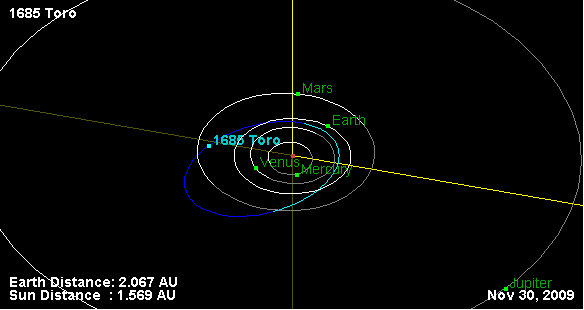Discovered by C. A. Wirtanen MPC designation 1685 Toro Discovered 17 July 1948 Orbits Sun Discoverer Carl A. Wirtanen | Discovery date 17 July 1948 Alternative names 1948 OA Aphelion 1.96 m | |
 | ||
Similar 2063 Bacchus, 4183 Cuno, Sun, 1580 Betulia, 1862 Apollo | ||
1685 toro top 6 facts
1685 Toro, provisional designation 1948 OA, is an eccentric stony asteroid and near-Earth object of the Apollo group, approximately 4 kilometers in diameter. It was discovered on 17 July 1948, by American astronomer Carl A. Wirtanen at Lick Observatory on Mount Hamilton, California.
Toro is an Apollo asteroid, a subgroup of near-Earth asteroids that cross the orbit of Earth. It orbits the Sun at a distance of 0.8–2.0 AU once every 1 years and 7 months (584 days). Its orbit has an eccentricity of 0.44 and an inclination of 9° with respect to the ecliptic.
The stony S-type asteroid is reported to be composed of L chondrite with a high albedo in the range of 0.24–0.34. It has an extremely well-measured rotation period of 10.2 hours.
Toro's orbit also shows a 5:8 resonance with Earth and in a near 5:13 resonance with Venus. It was the third Apollo asteroid to be discovered. The current resonance with Earth will last for only a few thousand years. Calculations show that Toro will leave it in 2960 AD, and that it will enter the region of 5:13 resonance with Venus in 3470. This is because the distance from Earth's orbit will become larger and that from Venus's orbit smaller. A study of long-term stability shows that the alternating resonances will possibly be broken roughly 3 million years from now because of close approaches between Toro and Mars.
Based on orbital paths, Toro is the best candidate for the source of the Sylacauga meteorite, the first meteorite authenticated to have struck a human, Mrs. Ann Hodges of Sylacauga, Alabama on 30 November 1954. Toro's Earth minimum orbit intersection distance of 0.0507 AU (7,580,000 km), is just above the 0.05-AU requirement to be listed as a potentially hazardous asteroid. With an orbital uncertainty of 0, its orbit and future close approaches are well determined.
This minor planet was named after the maiden name of Betulia Herrick, wife of American astronomer Samuel Herrick. Herrick had studied the asteroid's orbit, and requested the name, along with the other asteroid, 1580 Betulia. University of California, Naming citation was published before November 1977 (M.P.C. 2504).
